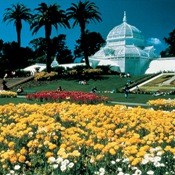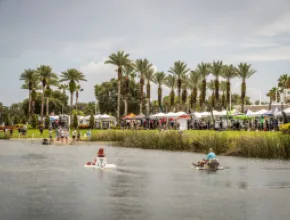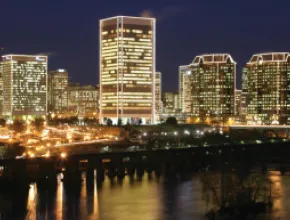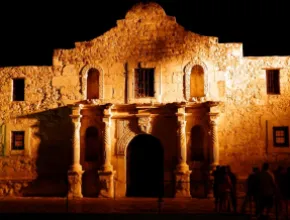A postcard city like San Francisco can easily opt to rest on its icons as a lure for visitors and groups. Clanging cable cars, picture-perfect hilltop views and the seductive towers of the Golden Gate Bridge make a lasting impact on visitors year after year.
But San Francisco also promotes its progressive nature, which this year comes in the form of new promotions and programs, as well as renewal in its myriad neighborhoods.
One of the key messages we’re putting out this year is “Foodies Come Home,” stated Laurie Armstrong, vice president of marketing and communications for the San Francisco CVB, at the February Outlook Conference hosted by the CVB. “We’re a top food and wine destination, and some other destinations are eating our lunch. It’s time to assert our culinary strength.”
One program used to promote the city’s cuisine is the new microsite Taste SF (www.onlyinsanfrancisco.com/taste), featuring stories about the city’s dining scene as well as its culinary history.
San Francisco’s green initiatives, including last year’s ban on plastic bags in chain supermarkets, is another recent “eco-thusiasm” promotion with a new microsite in the works, according to Armstrong. The green wave has already swept into the meetings industry.
“Green meetings moved from a trend to an expectation,” says Leonard Hoops, executive vice president of sales and marketing for the San Francisco CVB. “Every group is expecting some level of sustainability. There is a growing interest in what to do about the group’s carbon footprint. We need to position ourselves as a premiere green destination.”
Though the city’s main convention site, Moscone Center, was built prior to today’s standard LEED (Leadership in Energy and Environmental Design) specifications, it boasts comprehensive solar power and recycling programs. But Moscone itself faces challenges, including the need for upgrades to the Moscone North and South buildings, according to Hoops, who says the cost could run approximately $6 million.
“There is a CVB expansion task force looking into potential expansions for Moscone, including creating more contiguous space,” Hoops says. “We also need to upgrade our own technology—how leads are e-mailed out—and we need to offer a virtual tour of the convention facilities.”
Despite any shortfalls, Moscone is booked years in advance, making it a challenge for groups, especially associations that don’t have as much flexibility in booking dates as corporate groups, to find space.
“The biggest challenge is finding availability,” Hoops says. “The more flexible the group, the easier it is for us to handle. The more fixed, the more challenging it can be. We’re not different from any other destination. The availability is there. We need to work with groups to find dates.”
Moscone requires 1,800 peak rooms to use one of the buildings and 7,000 peak rooms to use all three, according to Hoops. If there is a short-term booking to fill a hole in the calendar, the criteria no longer apply.Hoops also notes the actual number of conventions is down from 59 in 2007 to 50 so far in 2008, leaving more holes to fill. However, the number of room nights has increased 25 to 30 percent, meaning the city is drawing larger conventions.
For smaller groups, there are alternatives. The Bill Graham Civic Center is undergoing a renovation and will reopen for group business in 2009. The Port of San Francisco has also formed a blue-ribbon panel to determine the future of the city’s cruise ship facilities, with the possibility of a mixed-use space opening to conventions when the cruise terminal is not in use. The San Francisco Giants baseball organization has also proposed a new arena and event space in Mission Bay near AT&T Park.
Also getting off the ground is a project started last year, Nob Hill Connection, a collaboration of three Nob Hill hotels—the InterContinental Mark Hopkins San Francisco, Renaissance Stanford Court and Fairmont San Francisco—in conjunction with the Nob Hill Masonic Center.
“We thought we could offer a solution for meeting planners different than the big box hotel,” says Michael Mettler, director of sales and marketing at the InterContinental Mark Hopkins San Francisco. Walking from one hotel to the next in this residential neighborhood is actually closer than some of the larger hotels downtown, he notes.
“We’ve had really good response in the number of leads for the Nob Hill Connection from a lot of meeting planners who might not have considered our hotels in the past,” Mettler says.
Nob Hill also has historic cachet as the location where California’s famous railroad tycoons—Charles Crocker, Collis Huntington, Leland Stanford, and Mark Hopkins—built their mansions, and real estate cachet for its views of the city and bay.
Nob Hill is just one of a number of attractive neighborhoods for groups. SoMa (South of Market), where Moscone Center is located, is undergoing change. This February the InterContinental San Francisco opened across the street, one of the few new brand-name, full-service hotels to debut in the city. The property, the largest new hotel opening in the city in nearly 20 years, offers 550 guest rooms and 43,400 square feet of meeting space.
“The whole area has shifted character in recent years,” Hoops says. “When Moscone opened it was still an industrial area. Now with high-rises popping up in the Mission Bay area near AT&T Park and residential condos at the St. Regis Hotel, places are staying open late, and more bars are opening to meet that crowd. It’s not shutting down when the convention is over.”
Another addition this year that will be open to groups is the Daniel Libeskind-designed Contemporary Jewish Museum, debuting in June next to the San Francisco Marriott. For off-sites, Bacar Restaurant and Wine Salon is actively pursuing groups with wine education events, private dining and a lounge for receptions.
Union Square is also on the upswing.
“One of the things meeting planners bring up to us regularly is that Union Square is not where it was,” Hoops says.
A little over a year ago the Union Square Business Improvement District created its own community benefit program, according to Hoops, through which businesses pay additional money for staff to keep the area clean and for a greater police presence.
Fashion outlet Barney’s added new life to Union Square with its opening last year. The 2006 debut of Westfield Shopping Center, anchored by Bloomingdales, has also proven a popular destination for groups.
Recent property renovations in Union Square include the Parc 55 Hotel, which underwent a $30 million upgrade, adding meeting space and a spa, and the Hilton San Francisco, which is slated to debut an additional 20,000 square feet of meeting space this month. The Sir Francis Drake Hotel and JW Marriott have also finished renovations.
In December, the former Crowne Plaza Union Square was rebranded Hotel 480, a 403-room property with 10,000 square feet of meeting space. Last year, the Argent became the Westin San Francisco Market Street, and the York Hotel will be rebranded the Hotel Vertigo when it reopens this summer.
Though Fisherman’s Wharf has always been a tourist magnet, the bayside locale was not a prime meetings destination until the Argonaut Hotel opened in 2003 with 7,000 square feet of meeting space. The Sheraton Fisherman’s Wharf recently upped the ante, adding 9,000 square feet of flexible meeting space as part of a $33 million renovation. The Hyatt at Fisherman’s Wharf also unveiled an upgrade last year. As for attractions, the San Francisco Maritime Museum is undergoing a multiyear renovation, while stalwarts like Pier 39 still bustle with out-of-towners.
Joie de Vivre reworked two hotels in Japantown, which itself is undergoing a transformation. The new properties are the Japanese-themed Kabuki Hotel and Best Western Hotel Tomo.
Other new projects include a $100 million, 142-room luxury hotel, Cavallo Point–The Lodge at the Golden Gate, slated to open this summer in Fort Baker on the north end of the Golden Gate Bridge. In addition, a new lodge is under development in the Presidio, which will provide the first overnight hotel accommodations in the Presidio since the Sixth U.S. Army turned the post over to the National Park Service in 1994.
In Golden Gate Park, the California Academy of Sciences will return to its original location, unveiling a Renzo Piano-designed facility this September.
San Mateo County
To the south of San Francisco, San Mateo County flaunts its accessibility as home to San Francisco International Airport (SFO).
There is much to boast of lately, with the addition of a number of airlines to the SFO roster. Three top low-cost carriers, Southwest, JetBlue and Virgin America, now operate daily flights from SFO, giving groups in all markets more options.
International attendees, a growing opportunity considering the faltering value of the dollar, are also benefitting with the addition of Aer Lingus direct flights to Dublin and additional upcoming frequencies for Korean Air and Air China, among others. India’s Jet Airways is also planning to debut with flights to Mumbai later this year.
Access to nearby facilities is another selling point. Venues close to the airport include the South San Francisco Conference Center, with 16,500 square feet of meeting space, as well as a number of meetings-friendly hotels, including the Hyatt Regency San Francisco International Airport, Marriott San Francisco Airport, Sheraton Gateway San Francisco Airport, and Embassy Suites San Francisco Airport, all of which recently underwent renovations.
But San Mateo offers more than just accessibility.
“The biggest misconception when we tell people we have SFO, which is a great asset for us, is that they start to picture us as an airport destination and say, ‘Never mind,’” says Anne LeClair, president and CEO of the San Mateo CVB. “But when we get them here, they say, ‘Oh my god, this is gorgeous.’ What they picture and reality are two different things.”
One of the county’s main cultural retreats, Redwood City, is undergoing a revival. Its historic Fox Theatre was recently refurbished and its Little Fox Theater is also a popular venue. The recently redone San Mateo County History Museum features the largest stained-glass dome in Northern California and is open for off-site receptions. The downtown Savvy Cellar Wine Bar offers wine tasting, while another winery two miles outside of downtown, the La Honda Winery, is also open to groups.
“The beauty of our county is that groups have options to stay all over,” LeClair says, referring to towns like San Mateo, Millbrae, Burlingame, and East Palo Alto, home to a Four Seasons hotel. San Mateo’s Benjamin Franklin Hotel will open in June as an upscale boutique property.
On the Pacific Coast side of the county “it’s a whole different world,” LeClair says. “It looks more like a leisure or resort destination. Groups love to go over and have a clam bake on the beach in rustic Half Moon Bay or Princeton-by-the Sea.”
Princeton-by-the-Sea is sporting a new venue, the Oceano Hotel & Spa in its Harbor Village, which also consists of boutiques and restaurants. The hotel offers meeting space as well as a glass-roof atrium for events.
For More Info
San Francisco CVB 415.974.6900
www.onlyinsanfrancisco.com
San Mateo County CVB 650.348.7600
www.visitsanmateocounty.com







